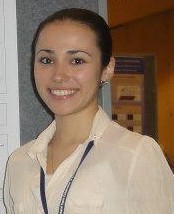
Sylmarie Dávila Montero
Undergraduate Student
Automated Information Processing Lab
Electrical and Computer Engineering Program
Puerto Rico University at Mayaguez
Call Box 9000, Mayaguez, PR 00681
Phone: +1 (787) 832-4040, ext. 5821
Email:
sylmarie.davila@upr.edu
BIO SKETCH
Sylmarie Dávila Montero is an undergraduate student with a specialization in Digital Signal Processing with a minor in Applied Mathematics. In the summer of 2012, She formed part of the Summer Undergraduate Research Experience (SURE) program at Georgia Institute of Technology (Georgia Tech). She worked with Dr. Maysam Ghovanloo in the design and implementation of a Graphical User Interface (GUI) for the Tongue Drive System (TDS), which is a tongue-operated, unobtrusive wireless assistive technology that enables people with severe Spinal Cord Injury (SCI), to control their environment. Over the last year, She is doing research in the UPRM, working with Dr. Domingo Rodríguez, in the develop of a Hearing Aids App on Android Devices, specifically in the treatment of the signals using mathematical language and digital signal processing techniques applied to the OMAPL138 C6-Integra DSP+ARM processing unit as development tool. She has had the opportunity to present her research project at conferences like Richard Tapia, ABRCMS and SACNAS, receiving the award for best poster presentation in the area of Computer Science in the latter. Sylmarie wants to be a university professor with a specialization in Bioengineering.
RESEARCH
-
Signal Processing Techniques for Digital Hearing Aid System.
This ongoing research deals with the problem of designing hearing aid system using digital signal processing techniques in order to address important issues such as providing algorithmic solutions with ease of programmability and reduced computational complexity. In particular, my research participation in this area centers on the design of signal processing algorithms to treat acoustic signals in order to reduce unwanted noise interference, enhance spectral characteristics, and improve precision of modeled electro-acoustic parameters.
This work presents preliminary results in the area of digital filter implementations using the Open Media Application Platform (OMAP) developed by Texas Instruments. For algorithm implementation, I am using the OMAP-L138 C6-Integra DSP+ARM processing unit. The types of filters being implemented are causal finite impulse response (FIR) filters. These filters were selected due to the fact that they are always stable and can be implemented indirectly using fast Fourier transform (FFT) algorithms. Special attention is being given to the analysis, design, and implementation of FFT algorithms used in hearing aid signal filtering techniques. The language of Kronecker Signal Algebra (KSA) is being used as a mathematical language to formulate the FFT algorithms and to assist as the overall signal processing algorithm development effort.
PUBLICATION
-
Computational Signal Processing Techniques for Digital Hearing Aid System Design - TAPIA '13:Richard Tapia Celebration of Diversity in Computing Conference.
-
Signal Processing Techniques for Digital Hearing Aid System – Poster for SACNAS Conference 2012.
AWARDS
-
Outstanding Poster Presentation Award in Computer Science presenting "Signal Processing Techniques for Digital Hearing Aid System" at the 2013 SACNAS National Conference (October, 2013).
LINKS
Advisor: Prof. Domingo Rodríguez


